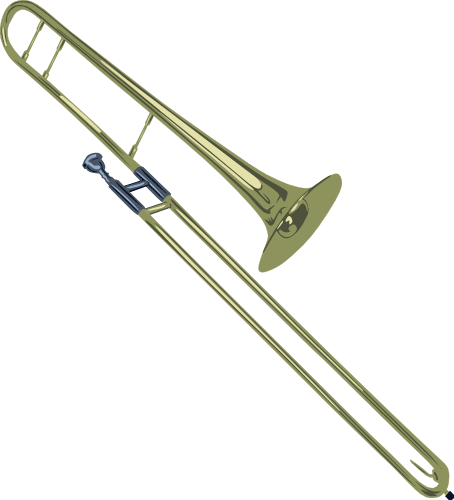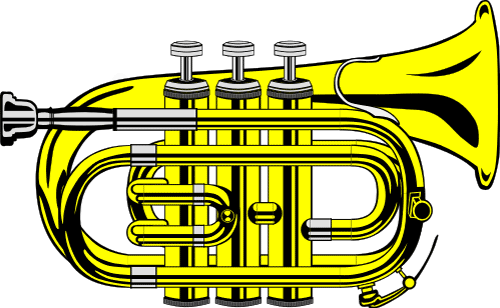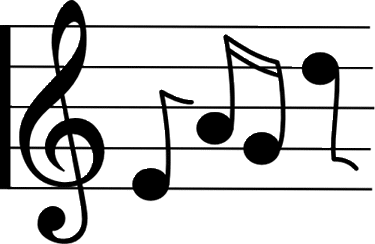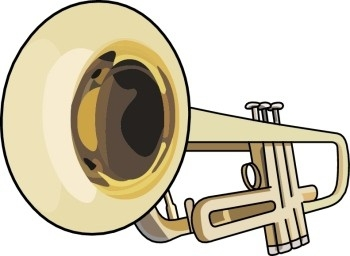
The Science of a Brass Musical Instrument.
C. W. Andreasen – revised 1.2.22
Ever
wonder why we always tune our brass
instruments using the open valves (no buttons
pushed)? The reason is because the natural pitch of
the instrument is with no valves depressed. We
tune with no valves down to set the natural pitch.
When we press a valve it adds length to the tubing
and it lowers the note. Any length of pipe has a
natural resonate frequency. Buzz your lips on one
end and you will see the longer the pipe the lower
the pitch. A trombone works on this principle in that
as the slide is moved out the length of the pipe, or
tube, gets longer. Any brass instrument, no matter
how nicely it is folded, is really nothing more than a
long tube. We tune in this natural condition with no valves pushed, to set the base
frequency (tone) in tune with the standard.
Each
valve adds a different length of tubing so pressing any valve makes
the pitch lower.
The first valve moves the pitch down 1 full step.
The middle (2 nd ) valve moves down ½ step
The third valve moves the pitch
down 1 and 1⁄2 steps.
Pressing valves adds tubing length to the air pathway.
Using logic you can see that if you want to go down 2 steps, you would use the 2 nd
and 3 rd valve together. All three valves down at the same time equals 3 steps.
If you press the 1 st and 2 nd valve at the same time you go one and a half steps, the
same as just the 3 rd valve alone, thus you may play any note that is normally played
with 1 st and 2 nd valves together, with just the 3 rd valve.
You might question why I say the pitch goes down, and the answer is that the
natural pitch does but with our lip we may go up. Take any note and hold the valves
the same and you can play many different notes, so holding down just the 1 st valve,
and using our lips, we can play F, Bb, D repeated for different octaves. Every valve
setting allows us to play a range of different notes. We normally play E (bottom note
on the Treble staff) with 1&2 valves, but any time any note, including E, which is fingered
1&2 can be played with just the 3 rd valve just as well. If an instrument has 4 valves,
the 4 th valve is the same as 1&3 but on low notes is more in tune. Pressing the 4 th
valve and the 3 rd valve at the same time opens up additional low notes that cannot
be played otherwise. For example, if one plays a descending C Major scale, starting at C
below the staff (low C), one of the notes (low D below the staff) cannot be played on
a 3 valve instrument, but 4 &1 will play it.

Most notes can be played with several different fingerings,
known as “alternate fingering”, learning this allows easier
fingering in some cases where normal fingering would be
difficult. For example, if I needed to jump back and forth
between
D (below the Treble staff) and G , I could just hold down valves 1&3
and use my lip only, because G can be played either open (no valves
depressed) or with the 1 st and 3 rd valves depressed. Most notes
have at least two different fingerings that can be used. Any length
of tubing has a resonate frequency but due to the sound waveform a nd
how it relates to the resonates we are able to play other notes that
are harmonically related.
nd
how it relates to the resonates we are able to play other notes that
are harmonically related.
Another very interesting feature of a brass
instrument is the bell. On one end it starts as
the same size as the tubing but it flairs out. I
will not go into the great technical details and
the science of the why it is this way but I will
tell you that if there is no bell, the instrument
would be hard to play and the sound would be awful. The instrument tubing slowly gets larger as you approach the bell. The bell makes a smooth curve from the tubing diameter until it curves to a right angle, or close to it. Here is the science part
in an overview; the bell is an impedance matching device. Any sudden change in
impedance causes problems. For example when you make ripples in a swimming
pool they move along the surface of the water until they hit the side of the pool,
then they bounce back. It gets complicated but as the waves bounce back and
interact with the still arriving ripples, they add or subtract from the wave, sometimes
canceling themselves out, or becoming double height, or anything in between.
They bounce back because there is a sudden change in impedance, or resistance, to
the flow. If there was a device that matched the impedance, the waves would not
bounce, they would just disappear, giving up the energy of the wave into the
matching device. These are known as “standing waves” when they bounce back.
When our sound comes out of the instrument, if there was a sudden transition from
the instrument to the air, there would be all sorts of bad effects, like the horn
becoming hard to blow, bad sound, and who knows what, all because the sound is
bouncing back on itself. The bell makes a smooth transition from the horn to the air
without any sudden change, no one rough spot, so it slowly changes the impedance
from the horn to match the impedance of the air. The smooth curve of the bell is
critical to the sound produced. A lot of ‘dings’ in the bell can change the sound of
the instrument
There is a lot of science in how a brass instrument works. It is not the horn that
makes the sound, or the valves that set the pitch, they just set the environment and
our lips and the vibration we make (the buzzing) is what makes the sound. It is the
player and the instrument working together that make music.